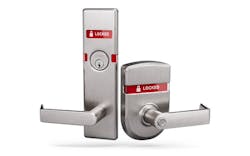Using Locking Hardware to Support Code-Compliant Safer School Design
Safer school design encompasses many elements of the built environment—from the property line to classroom door openings. All these pieces need to work together properly to enhance school safety and security. As such, safer school design brings together building, construction and security communities. With so many different stakeholders, it can be difficult to parse the various best-practice recommendations from organizations like the Partner Alliance for Safer Schools (PASS), the International Code Council, the Final Report of the Sandy Hook Advisory Commission, the Final Report of the Federal Commission on School Safety and many others.
To simplify this process, there are available summaries of best practices, including complete overviews of several recommendation reports and focused discussions on specific elements of safer school design. No matter the resource used, there will always be an emphasis on developing infrastructure and protocols that balance the need to consider a wide range of threats. From maintaining free egress during a fire to supporting bully prevention initiatives, it is important that school security measures do not create unintended consequences.
This is especially crucial when specifying locking hardware. Often cited as one of the more difficult elements of the built environment to specify—there is even an entire blog dedicated to answering common questions around these systems. The difficulty of selecting the right door hardware increases as demands placed on it grow. The following will provide some key considerations for specifying locking hardware that also contributes to safer school design and peace of mind for students, faculty and parents.
Selecting locking hardware with the proper functionality
Choosing locking hardware that is code-compliant is both a building requirement and a recommendation from several safer school design best-practice resources. Organizations like PASS recommend classroom room door locks be lockable from inside the room without opening the door, keys or other credentials should always be in the possession of teachers and staff and locks should have visual indicators so occupants can see the status of the door. In addition, current model codes require locked rooms be accessible from the outside with a valid key or credentials to support first responders. Likewise, it is recommended that if locks are designed to prevent access at all times (ex. storeroom function), proper protocols are implemented to prevent propping open the door or using a magnet to prevent the latch from engaging in the strike.
Instead, specifiers are encouraged to use locks with either the entrance/office function or the classroom security function. Locks with the entrance/office function engage with a thumbturn or push button. The door’s inside lever remains unlocked at all times, allowing occupants to exit freely. This function helps occupants easily lock the door during a lockdown, regardless of who has the key. Because this hardware does not require special knowledge, even students can initiate a classroom lockdown. On the other hand, the ability for anyone to lock the door poses risks of bullying and other bad behavior. The use of a key override may help mitigate this risk.
The classroom security function requires a key to lock a door from either the inside or the outside. This allows the door to be locked without opening the door during a lockdown. It also prohibits unauthorized people from locking classroom doors. Because some states or school districts have adopted specific guidelines regarding the types of locksets used in classrooms, it is important to consult the local requirements. Further, like the storeroom lock, it may cause disruptions during class, which may tempt occupants to prop the door open. Finally, locating and using the key to operate the door in high-stress situations may complicate lockdown protocols.
In order to choose the best locking hardware for a specific application, specifiers are encouraged to consult with school administration, security professionals and the Authority Having Jurisdiction (AHJ) to ensure that a lock meets security goals and code requirements.
Achieving safer school design in areas outside the classroom
Properly specified locking hardware can enhance school safety and security. In fact, the Final Report of the Sandy Hook Advisory Commission stated, “The testimony and other evidence presented to the Commission reveals that there has never been an event in which an active shooter breached a locked classroom door.”
This benefit extends beyond classrooms to gymnasiums, auditoriums, media labs, cafeterias and other areas where students assemble. That said, these larger spaces may typically require different door hardware based on local codes. Often, assembly spaces require panic hardware, which are door-latching assemblies that release their latch upon the application of force in the direction of egress travel. This type of door hardware ensures swift and easy egress during emergency evacuations and must meet several specifications to allow unimpeded egress without special knowledge. Some types of panic hardware can be locked on the entry side of the space to prevent access but maintain free egress while other types cannot. This is important to consider when planning to enhance school safety and security since these spaces can be a part of a multilayered approach to safer school design. Controlling access to assembly areas can help create time barriers during in an emergency.
But panic hardware differ from other door hardware in a number of ways. In terms of school safety and security, it may be difficult for occupants to quickly verify if the assembly is locked in a high-stress situation. In these instances, exit hardware with visual indication of the status of the door can provide both peace of mind that a door is locked and help minimize operational error.
The consideration above points to a more general concern when it comes to safer school design. Emergency situations can be chaotic and uncertain. Locks with visual indicators can help remove some of that uncertainty, as teachers and students can quickly confirm the status of a door, locked or unlocked.
Locks with indicator windows that are large and include 180-degree visibility can further enhance school safety and design by allowing assessment from greater distances or from areas that are not directly in front of the locked door. Not only does this streamline lockdown protocols in classrooms, but it can also work with other school security measures (like the use of hard corners in shelter-in-place locations) to support the effectiveness of such strategies.
Door locks are an integral part of safer school design, and locking hardware with visual indicators can provide additional peace of mind for students and teachers, helping them feel safe and enabling an environment where they can thrive.


